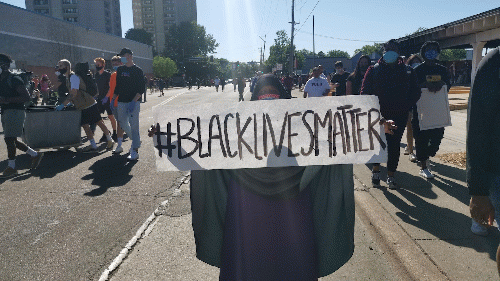From Peoples Dispatch

Woman on the streets of Minneapolis holds #BlackLivesMatter sign.
(Image by Photo: Breakthrough News) Details DMCA
There is no need to wonder why George Floyd (age 46) was murdered in broad daylight in Minneapolis, Minnesota, on May 25, 2020. The script of his death is written deep in the ugly drama of US history.
I Can't Breathe 2020Officer Derek Chauvin's knee sat on George Floyd's neck for eight minutes and 46 seconds. After that time, George Floyd was dead. From the moment Chauvin put his body on an unarmed man, George Floyd said -- 11 times -- I can't breathe.
Scientists who study human respiration say that untrained people can hold their breath from between thirty seconds and two minutes; anything more than that results in a process that leads eventually to death.
Officer Daniel Pantaleo slammed Eric Garner onto the New York City sidewalk just minutes after Garner had helped resolve a dispute on the street. Pantaleo pushed Garner's face onto the pavement, and Garner said -- 11 times -- I can't breathe.
Garner lost consciousness, did not receive medical care in the ambulance, and was pronounced dead soon after arriving at the hospital. He died, effectively, of strangulation.
DismayedBoth Floyd and Garner were African American; both were men who struggled to make a living in a harsh economic environment.
The UN Human Rights head Michelle Bachelet wrote a powerful statement in response to the death of George Floyd: "This is the latest in a long line of killings of unarmed African Americans by US police officers and members of the public. I am dismayed to have to add George Floyd's name to that of Breonna Taylor, Eric Garner, Michael Brown and many other unarmed African Americans who have died over the years at the hands of the police -- as well as people such as Ahmaud Arbery and Trayvon Martin who were killed by armed members of the public."
Each year in the United States, more than a thousand people are killed by the police; African Americans are three times more likely to be killed by the police than whites, and African Americans who are killed by police are more likely to be unarmed than whites. Most of these killings are not associated with serious crime. Astoundingly, 99 percent of the officers who kill a civilian are not charged with a crime.
Permanent Depression"The Depression," the poet Langston Hughes wrote of the 1930s, "brought everybody down a peg or two." It was different for African Americans, for they "had but few pegs to fall."
Garner was accused of selling loose cigarettes on the street, violating excise tax laws to make a few dollars; Floyd was accused of using a counterfeit $20 bill. Even if these accusations could have been proved, neither were earth-shattering crimes; if they had gone to court, neither would have earned these men death sentences. They were killed after being accused of minor infringements.
When Hughes wrote those words, Lino Rivera, a 16-year-old Afro-Puerto Rican boy, had been arrested for shoplifting a 10-cent penknife. A crowd gathered when the police went to arrest him, a rumor spread that he had been killed, and Harlem rose up in anger. A government report later showed that the protests were "spontaneous" and that the causes of the unrest were "the injustices of discrimination in employment, the aggressions of the police, and racial segregation." This report could have been written last week. It suggests a permanent Depression.
System Cannot Be ReformedHistorically, police aggression has come before any unrest. In 1967, unrest in Detroit spurred the US government to study the causes, which they assumed would be communist instigators and an inflammatory press. The riots, the National Advisory Commission on Civil Disorders (the Kerner Commission) said, "were not caused by, nor were they the consequences of, any organized plan or 'conspiracy.'"
Instead, the Kerner Commission said that the cause of the unrest was structural racism. "What white Americans have never fully understood," the report noted, "is that white society is deeply implicated in the ghetto. White institutions created it, white institutions maintain it, and white society condones it." By "ghetto" the report's authors meant the atrocious class inequalities in the United States that had -- because of the history of enslavement -- been marked by race.
Rather than address the deep inequalities in society, the American government chose to heavily arm police officers and send them to discipline populations in distress with their dangerous weapons. The commission proposed instead "a policy which combines ghetto enrichment with programs designed to encourage integration... into the society outside the ghetto."
(Note: You can view every article as one long page if you sign up as an Advocate Member, or higher).





